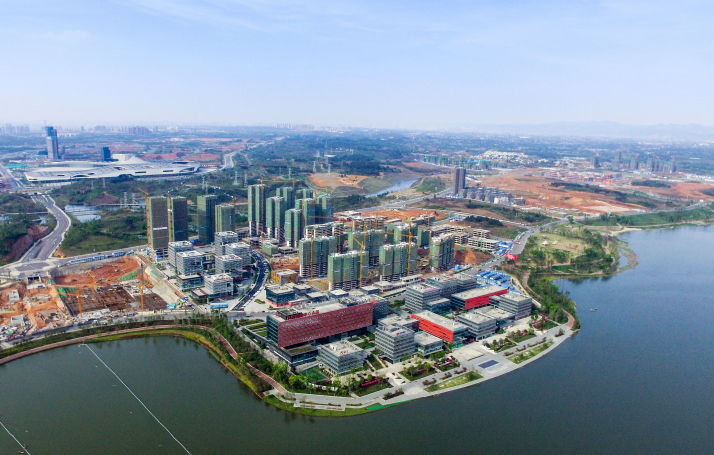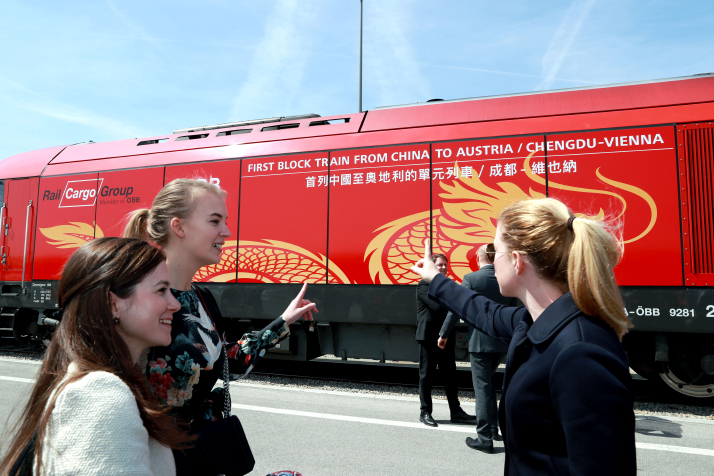| China |
| Land of Abundance | |
| How reform, opening up and the Belt and Road Initiative made Chengdu a link to the West | |
|
|
 The Chengdu Tianfu New Area of the China (Sichuan) Pilot Free Trade Zone, a national-level new economic zone (XINHUA)
It was business opportunities in China that made Kasper Kristensen decide to move home from Denmark to Chengdu in southwest China. "My Chinese friends and their families want to buy high-quality and safe products, and they know they can get that from Denmark," said the 44-year-old Dane. "Living standards are rising fast in China and the growing middle class now want the best for themselves and their families." In 2016, he founded Royal Farm, selling milk powder and protein supplements in Copenhagen Airport, health shops in Denmark and Sweden, and online in Scandinavia. Then last year, he moved to Chengdu. Royal Farm can be regarded as a mini model of globalization. Its other co-owners are Fu Tian, a Chinese pharmacologist, Jeppe Schoubye, a 23-year-old from Denmark, and Raymond Wong, whose family is from Hong Kong but who was born in Denmark. Its offices are located in Chengdu, Copenhagen and Odense in Denmark, with the factory in Odense. New gateway to China Why Chengdu in inland Sichuan Province and not Beijing or Shanghai? "Mainly because of the new development in Chengdu: the Belt and Road Initiative and the free trade area in Chengdu," Kristensen answered. "We consider it the new gateway to China." Chengdu's Vice Mayor Wang Pingjiang described how the city turned from hinterland into a new frontier of development. With an annual growth of 7.9 percent for the last three years, the eighth largest city in China in terms of GDP, and listed as one of the world cultural cities recognized by UNESCO, it is home to over 280 Fortune 500 companies. With the local government's decision to be more involved in the Belt and Road Initiative and step up connectivity, the China (Sichuan) Pilot Free Trade Zone (FTZ) was launched on April 1, 2017, one of the third batch of the Central Government-endorsed pilot FTZs. The FTZ consists of three areas: the Chengdu Tianfu New Area, Qingbaijiang Railway Port Area and South Sichuan Port Area. It is Qingbaijiang where Royal Farm has its warehouse. The Chengdu-Europe Express that pulled out of Qingbaijiang for Lodz in Poland in 2013, flagging off the China-Europe freight service and linking Europe, Central Asia and Southeast Asia with over 2,240 trains, has slashed goods transportation costs and boosted trade and investment. Before the service, it took between 90 days and two and a half months for shipments to reach Europe. Now, the time has been reduced to three weeks. When the service first started, the train would leave for Europe carrying Chinese goods but on the way back, would be nearly empty. However, when European traders discovered the new route, they began sending their containers to China by rail, especially with the railway authorities offering attractive rates. Today, "the train accounts for one fourth of China's Europe freight trains," the vice mayor said. "It has made us able to reach China faster, cheaper and better. It is a project that will bind Europe and China together not only with products but with cultural exchange, and a deeper understanding between us," Kristensen said. He and his partners now have a second company, Royal Boulevard, that has signed up with around 50 Nordic companies to market products made in Europe—from wine to diapers and household products. From Qingbaijiang, the products are sold both online—such as on Chinese e-commerce platforms like Taobao, Tmall and JD.com, and in select brick-and-mortar stores. It is also partnering with a local company, Meishan Organic, to sell organic food products and beverages, and will open their first store in Meishan around the Chinese New Year. This will be followed by 99 more stores in this town of 3 million people. Future plans involve working with small and medium-sized Chinese enterprises to sell "made in China" products in Europe, from technological items to baby carriages.  A China-Europe freight train linking Chengdu with Vienna, capital of Austria, arrives in Vienna on April 27 (XINHUA)
Route to Europe A company called Terroir was importing French wines on the Chengdu-Europe train. As more government policies to support cross-border e-commerce followed, the team decided to use their expertise in the wine business and imports and co-found a Chengdu-based company, Sichuan Rongouzhilian Technology. Guillaume Chamant, who comes from northeast France, became a part of that business by destiny. In 2016, he had come to Chengdu as a business management student on an exchange program to study in Sichuan Agricultural University. After two months, he interned with a local company associated with Terroir, and due to this connection, when Sichuan Rongouzhilian Technology started, he joined it and moved to Qingbaijiang. He helps manage the French pavilion there that assists Chinese companies and customers in buying wines through cross-border e-commerce. "Chengdu is a really a dynamic city that wants to be the biggest in west China," the 26-year-old said. "It has become a business hub with the international railway port and the new airport under construction. The business environment is friendly here and the cost of living is really cheap, an important thing to take into consideration. The number of foreigners living here is growing every year, so the connection with the West is increasing." About one third of Sichuan's foreign trade and 80 percent of its foreign-contracted projects are located in countries along the Belt and Road, according to local government data. The three-dimensional modernized logistics system for international trade consists of, in addition to the railway port, the Shuangliu International Airport with over 100 international routes and the Luzhou Port that has opened sea routes to Japan, South Korea and China's Taiwan and Hong Kong. Once the construction of the Tianfu International Airport is completed, Chengdu will be the third city in China with two international airports. The China-European Center, jointly established by the Ministry of Commerce and the European Union, is becoming a national-level platform for opening up and cooperation. "Chengdu is also a platform for production capacity cooperation among the international community," Yao Yi, Director of the Institute of Economics at the Chengdu Academy of Social Sciences, said. "It has established bilateral industrial parks with Germany, France, Italy and South Korea. Chengdu was among the first cities in central and west China to implement a 72-hour visa-free transit policy, which is planned to extend to 144 hours on January 1, 2019. Chengdu has also established 'friendship city' relations with 34 cities worldwide." The cultural touch While its reputation as a business and exhibition city is growing, Chengdu already enjoys fame as a prime culture and tourist destination, thanks to its scenic beauty, cultural treasures such as Sichuan Opera and Shu embroidery, and of course, its giant panda sanctuary and panda research and breeding center. Recognized as one of the top 17 global tourism destinations by CNN in 2017, the city with an urban civilization of 4,500 years received over 200 million visits from home and abroad in 2017. In June, the Belt and Road World Cities Culture Center was established in Chengdu, and in November, it reprised its status as the happiest city in China in a survey conducted nationwide, for the 11th time. On a foggy day last month, Yury Tavrovsky, armed with a camera, was among the visitors at the panda research and breeding center, clicking away at the much-adored sleeping, munching or mildly playful giant bears. However, the research coordinator at the Izborsk Club, a think tank in Moscow, had a huge difference from the average visitor. Tavrovsky admitted that he was not a big fan of pandas. Still he was there because the Sinophile and author of four books on China was working on a new project. He was enlarging his first book, Magnificent China, based on the sketches of the places he visited in China 10 years ago and the people he met. Due to Chengdu's high-speed growth, he was going to include a chapter on the city. For that, pandas were obligatory, as well as tales of Sichuan's cuisine, especially the hotpot. But he had another subject in Chengdu that was closer to his heart, Du Fu, the famous eighth century poet. "We studied Du Fu's classic poems in Leningrad University," Tavrovsky said. "He had an association with Chengdu. He stayed here for four years and the villa is still extant. These would be the finishing touches to my book." (Reporting from Chengdu, Sichuan Province) Copyedited by Craig Crowther Comments to luyan@bjreview.com |
|
||||||||||||||||||||||||||||||
|
